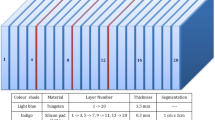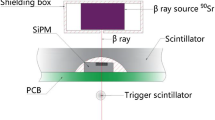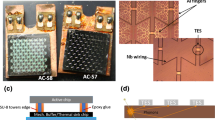Abstract
For the forward direct photon measurement at LHC-ALICE, we propose to construct a Forward Calorimeter (FoCal). FoCal-E is a silicon and tungsten calorimeter design, consists of low granularity Si-Pad layers (LGL) for precise measurement of photon energy and a few high granularity layers (HGL) with pixel readout to achieve an excellent position resolution to separate two photons from \(\pi ^0\). We performed R&D of LGL prototype since 2014. From results of past three years tests (2014 \(\sim \) 2016) at CERN PS and SPS, LGL prototype has a good linearity and the energy resolution is about \(10\%\). In addition, good agreement with theoretical values and simulation were observed about longitudinal shower profile.
Access provided by CONRICYT-eBooks. Download conference paper PDF
Similar content being viewed by others
Keywords
1 Introduction
The initial state of high energy collisions is likely to originate from small-x gluon (\(10^{-5}\) \(\sim \) \(10^{-6}\)), which are expected to reach a saturated state, called the Color Glass Condensate(CGC) [2]. We propose to perform a direct photons measurement at large rapidity, to gain direct information about CGC picture, and the initial conditions for heavy ion collisions at high energies.
For this measurement, we are proposing to construct a Forward Calorimeter (FoCal) in ALICE. FoCal measures direct photons at large rapidity (\(3.5< \eta < 5.3\)). Thereby, one can explore small-x structure like CGC and initial state.
2 Design of Si-W Calorimeter
FoCal consists of two components which are electromagnetic calorimeter (FoCal-E) and hadronic calorimeter (FoCal-H). The design of FoCal-E is shown in Fig. 1. FoCal-E is a sampling calorimeter which is made of silicon and tungsten. Tungsten plate is used as an absorber which has a very short radiation length (\({\sim }\)3.5\(\,\mathrm {mm}\)) and a small Molière radius (\({\sim } 9.3\;\mathrm {mm}\)). As a detection layer, we use two types of silicon sensors. For the low granularity layers (LGL), silicon pad sensors (Si-Pads) with \(1\times 1\;\mathrm {cm^2}\) granularity, and analog readout are used, for a precise measurement of the photon energy. For the high granularity layers (HGL), monolithic active pixel sensors (MAPS) with \(30\times 30\;\mathrm {\mu m^2}\) granularity, and digital readout are used, for identification of \(\gamma \) and \(\pi ^{0}\) [3].
3 Test Beam at CERN PS and SPS
3.1 Test Beam Setup
We have performed the test beam experiments for a LGL prototype at CERN PS and SPS since 2014. This prototype was designed and assembled by ORNL. In test beam, we use 16 layers of LGL and each layer has 64 Si-Pads (Hamamatsu S10938-9959). To reduce the number of output channels, we use a summing board which sums 4 layers of sensor signals longitudinally. Further, summing board has two gains depending on the deference in the polarity of readout. Positive readout is 1/1 output and negative readout attenuate a signal by 1/16. We adopted the SRS (Scalable Readout System) and APV25 hybrid chip as a front end module, both developed by the CERN-RD51 collaboration [4, 5]. We use mmDAQ which is also used in ATLAS micromegas as the data collection application. The detector setup for the test beam experiment in 2015 is shown in Fig. 2. The beam comes from the right side in the photograph. Beam is triggered by four scintillation counters. Four independent APV25 hybrid are attached on summing boards and connected to SRS. Two HGL layers are inserted in front and behind the 2nd LGL module, to achieve a setup that is similar to the FoCal design in Fig. 1.
3.2 Results
Two test beam experiments were performed at SPS in 2015, and 2016, using mostly lower energy beams with energies up to 50 GeV in 2015 and high energy beams of \(110\;\mathrm {GeV/c}\) and \(130\;\mathrm {GeV/C}\) in 2016. Between the two periods, a new summing board was installed, to attenuate the signal more strongly for measurements in the high energy range. Figures 3 and 4 show the summed ADC value in all segments as a function of beam energy. The lower panel of Fig. 3 shows the ratio to a fit with a linear function. It indicates good linearity within \(3 \%\). In 2016 data shown in Fig. 4, although it only has two points, it also shows good linearity. However, in 2016 data has a small offset from the origin. This is because that 4th LGL had dead channel in the shower center.
Energy resolution is shown in Fig. 5. This plot is obtained as a ratio of mean of ADC SUM and the widths of Gaussian by the fits. The data from different years are indicated by different colors (blue and black). Note that no calibration of the sensor sensitivities was performed. To characterise the energy dependence of the energy resolution, the data points are fitted with an equation; \(\frac{\sigma }{E} = \frac{\sigma _{\mathrm {stchastic}}}{\sqrt{E}}\oplus \sigma _{\mathrm {constant}}\). The constant term indicates the intrinsic performance of the detector and the stochastic term is due to sampling or particle number fluctuations. As a result, constant term is \(9.7\%\) in 2015. Although it might be the resolution is getting worse in 2016 compared to in 2015 (both value is about \(\sim 15\%\)), this is also due to dead channel noted before. The violet curve is a simulation which reproducted the situation of the test beam without electronic noise. And the red curve is ideal simulation which is assumed no noises and no dead channels. These two simulation indicate that the effect of dead channel gives a significant influence of about \(5\%\) worse in the energy resolution. Hence, it is expected that the resolution will be improved by repairing the dead channels.
Figure 6 shows the average response in each of the four modules as a measure of the longitudinal shower profile, for 110 GeV and 130 GeV beams. The ADC values summed by the each summing board are plotted as a function of the corresponding radiation length. The data agrees with the theoretical expectation, i.e. the shower maximum is located at about \(9\;\mathrm {X}_{0}\). The measured value (circle markers) are compared to the result from Geant4 simulations without dead channels (star markers) and with dead channels (diamond markers). As the data is not calibrated yet, the energy scale between measured ADC value and simulated value for ADC is arbitrary. However, the shape of shower growth is matched well between data and simulation.
4 Summary
We have tested a silicon and tungsten based electromagnetic calorimeter (LGL) prototype for a proposed upgrade of ALICE. As results, LGL detector of FoCal-E has a certain performance as a calorimeter in term of linearity, energy resolution and expected longitudinal shower profile. As an outlook, we are going to make a new type of LGL prototype which fulfills the requirement for the physics measurements based on current on the experiences of the current prototype.
References
The ALICE FoCal Collaboration: Letter of Intent A Forward Calorimeter (FoCal) for the ALICE experiment (2016)
Rezaeian, A.H.: Phys. Lett. B 718, 1058 (2013)
Wang, H.: High granularity digital Si-W electromagnetic calorimeter for forward direct photon measurements at LHC
SRS Slow Control Manual
Jones, L.: APV25-S1 UserGuide Version 2.2, RAL Microelectronics Design Group system (2001)
Acknowledgemtent
This work was supported by JSPS KAKENHI Grant Numbers JP25287047, JP26220707, JP17H01122.
Author information
Authors and Affiliations
Consortia
Corresponding author
Editor information
Editors and Affiliations
Rights and permissions
Copyright information
© 2018 Springer Nature Singapore Pte Ltd.
About this paper
Cite this paper
Kawamura, Y., for the ALICE FoCal Collaboration. (2018). A Si-PAD and Tungsten Based Electromagnetic Calorimeter for the Forward Direct Photon Measurement at LHC. In: Liu, ZA. (eds) Proceedings of International Conference on Technology and Instrumentation in Particle Physics 2017. TIPP 2017. Springer Proceedings in Physics, vol 213. Springer, Singapore. https://doi.org/10.1007/978-981-13-1316-5_16
Download citation
DOI: https://doi.org/10.1007/978-981-13-1316-5_16
Published:
Publisher Name: Springer, Singapore
Print ISBN: 978-981-13-1315-8
Online ISBN: 978-981-13-1316-5
eBook Packages: Physics and AstronomyPhysics and Astronomy (R0)










